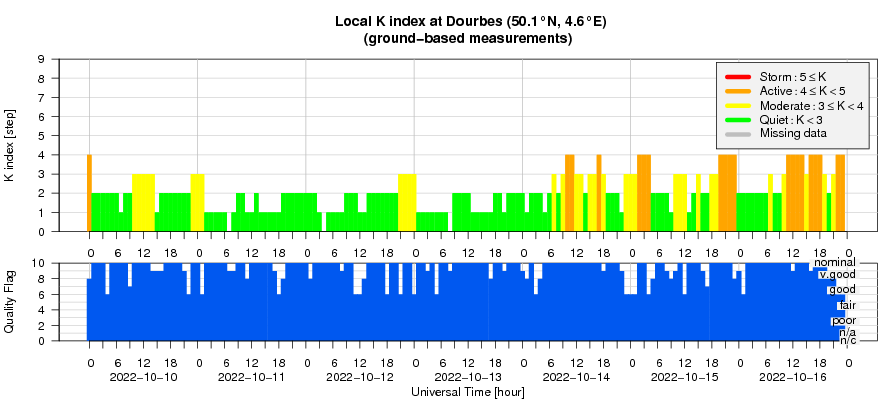- Table of Content
- 1.Fun with the S...
- 2.Review of sola...
- 3.Review of geom...
- 4.The SIDC Space...
- 5.The Internatio...
- 6.PROBA2 Observa...
- 7.Noticeable Sol...
- 8.Geomagnetic Ob...
- 9.Action!
2. Review of solar activity
3. Review of geomagnetic activity
4. The SIDC Space Weather Briefing
5. The International Sunspot Number by SILSOal
6. PROBA2 Observations (10 Oct 2022 - 16 Oct 2022)
7. Noticeable Solar Events (10 Oct 2022 - 16 Oct 2022)
8. Geomagnetic Observations at Dourbes (10 Oct 2022 - 16 Oct 2022)
9. Action!
Fun with the Sun!
On 25 October, a partial solar eclipse will be visible from most of Europe, northeast Africa, the Middle East and the western portion of Asia. In order for a solar eclipse to happen, it is required that the Moon moves right between the Sun and Earth, and thus that Sun, Moon and Earth are on a straight line. However, in this case, the alignment is not perfect. Indeed, the central axis of the Moon's shadow will be directed slightly over (to the north of) the Earth, and thus the eclipse will be partial only from each location in this eclipse area, with nowhere a total eclipse (it will not get "dark" during the day). The Moon will cover the most of the Sun's disk in Russia (86% of the solar diameter). The annotated map underneath was taken from the Yearbook of the Royal Observatory Of Belgium (ROB) (https://www.astro.oma.be/en/information/publications/the-yearbook/ )and shows where the eclipse is visible. "P" means partial eclipse (fully visible), "p" also means partial, but only part of the eclipse is visible (at sunrise or sunset). The red dot marks the approximate location of Belgium.
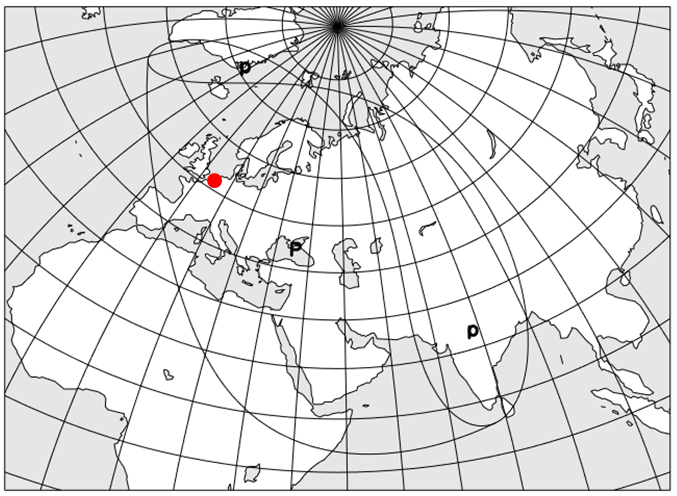
From Belgium, the eclipse will be visible in its entirety, and will be partial everywhere. In Uccle, the eclipse will start at 11:09:34 local time (UTC + 2 hours) and end at 13:00:52, timings known respectively as "first contact" and "last contact". The maximum phase will take place at 12:04:21. At that moment, 30,1% of the Sun’s diameter will be covered by the Moon, corresponding to a coverage of about 19% of the visible surface of the Sun. This is slightly larger than the previous eclipse on 10 June 2021, when at Uccle the Moon covered only 26.3% of the apparent solar diameter. Timings and size of the eclipse will vary slightly from location to location in Belgium. For example, the eclipse will be smallest in the Westhoek (around 28.5%), and largest in Limburg (near 32,4%). Details can be found in the Yearbook or on this dedicated website (http://robinfo.oma.be/en/astro-info/eclipses/eclipses-2022-en/#eclipse-25-october-2022 ). The colorized image underneath was taken by the USET telescopes in Uccle, Belgium (https://www.sidc.be/uset/ ) during the previous eclipse on 10 June 2021 at 12:19 local time (maximum phase). The borderline between the Sun and the Moon is not sharp but seems somewhat irregular due to the mountains and valleys present on the atmosphereless Moon.
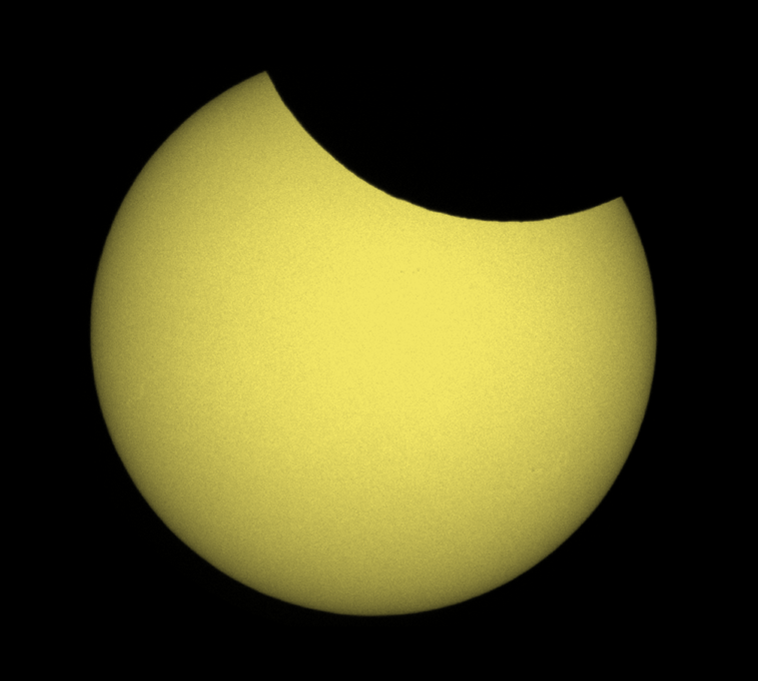
Solar instruments operated by the ROB will observe the eclipse. Weather permitting, the Uccle solar telescopes will take pictures in visible light ("white light"), as well as in the red and blue portion of the visible solar spectrum. The white light images show sunspots (magnetic disturbances at the solar surface), whereas solar images in the red H-alpha spectral line show prominences (near the solar limb) and solar flares. The images in the blue portion show bright regions named chromospheric plages, indicating areas of enhanced magnetic fields. High above the Earth's clouds, the SWAP camera on board the PROBA2 satellite will take pictures in extreme ultraviolet (EUV) light, showing magnetic loops and bright active regions in the corona (Sun's outer atmosphere) at temperatures near 1 million degrees. As PROBA2 orbits the Earth rapidly (about once every 100 minutes), SWAP has an ever-changing view of the eclipse. It's always fun to see which features are covered by the Moon as it transits the solar disk. The images underneath show the Sun during the eclipse of 10 June 2021 in H-alpha (through a small telescope, notice the prominence to the left), and in EUV (PROBA2/SWAP).
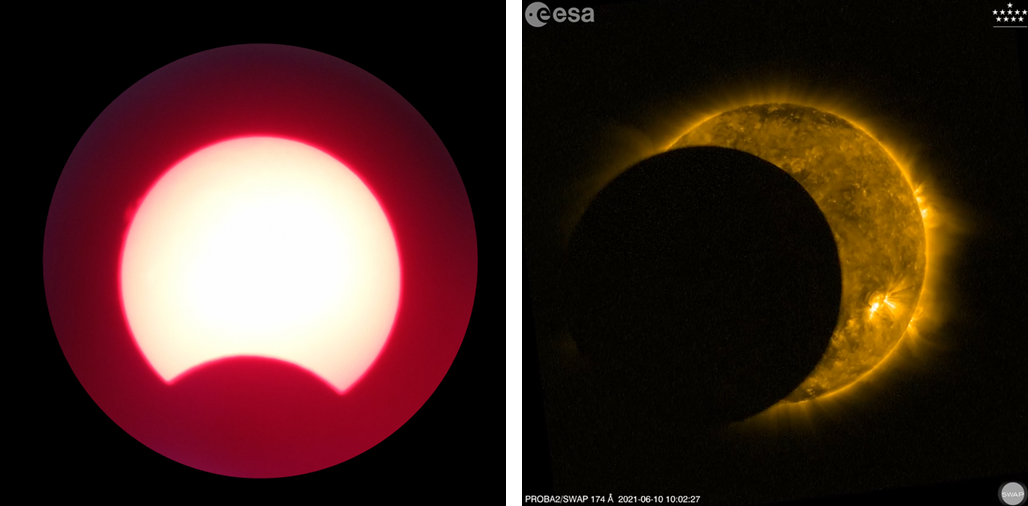
When observing a solar eclipse, please be careful and always (and only) use solar eclipse glasses or welding goggles. Also safe is to project the image of the Sun through a small point in cardboard on the ground, on a wall or in a box. Always look at the shadow, never to the Sun. In the past, people have been very creative to adapt this "camera obscura" or "pinhole camera" to their own possibilities. Beach hats, kitchen sieves, the punched card of a hotel room,... they all did the trick. Even the small holes between overlapping tree leaves can make the partially eclipsed Sun become visible (image underneath), though it's now already autumn and the tree foliage is thinning. The relatively small size of the eclipse is also not helping. Nonetheless, the most important is just to have some fun, because for Belgium, the next (partial) solar eclipse will only be on 29 March 2025.
The eclipse can be followed at the ROB/USET (https://www.sidc.be/uset/Eclipse2022/ ) and PROBA2 (https://proba2.sidc.be/Eclipse2022Oct25 ) websites, which provide also additional explanations.
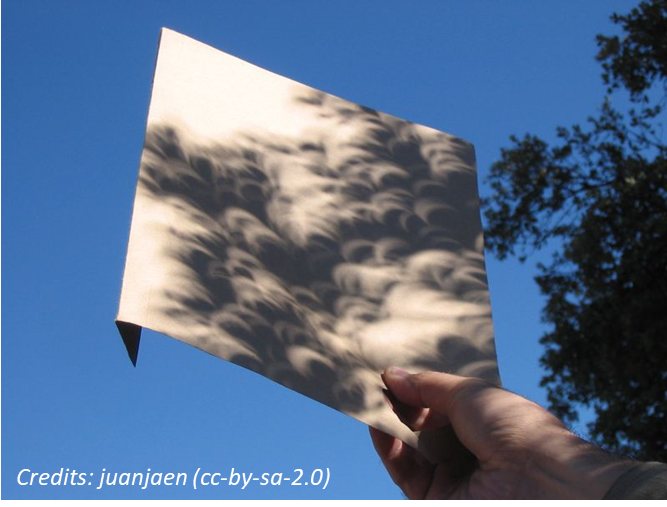
Review of solar activity
Flaring activity
Seven active regions (AR), NOAA ARs 3111, 3112, 3115, 3116, 3118, 3119, 3120 were visible at the start of the week. NOAA AR 3112 was the one driving the flaring activity. It produced five M-class flares on 10, 11, 13, 14 October. This AR reached a beta-gamma-delta magnetic field configuration. By the end of the week NOAA ARs, 3119, 3121, 3122, 3123 were visible, all with simple magnetic field configuration (alpha or beta) and not producing any significant flare activity.
Solar wind disturbances: Coronal Mass Ejections
Three (similar) CMEs with a possible Earth component were detected on 10, 13 and 14 October. They originated from the same region which was located in the southern hemisphere of the sun. The CME's were slow (about 300 km/s) and narrow with angular widths around 90 degrees.
Solar wind disturbances: Coronal Hole
A small negative polarity coronal hole, located in the northern hemisphere, crossed central meridian on 11 October.
Review of geomagnetic activity
At the beginning of the week the solar wind at the Earth was fast, coming from an equatorial coronal hole with positive polarity (from the previous week). From 11 to 14 October the Earth was within slow solar wind. On 14 October we saw the combined influence of the coronal hole with negative polarity (located in the northern hemisphere) and the ICME corresponding to the CME of 10 October. The magnetic field intensity reached 18 nT with Bz down to -14nT on 14 October. The solar wind speed reached 600 km/s and it was still elevated at the end of the week.
Geomagnetic activity was at quiet to unsettled levels until the arrival of the high speed stream and ICME on October 14. It then reached active levels locally (K_Dourbes up to 4) and minor storm conditions globally (Kp up to 5).
The SIDC Space Weather Briefing
The Space Weather Briefing presented by the forecaster on duty from Oct 10 to 16. It reflects in images and graphs what is written in the Solar and Geomagnetic Activity report: https://www.stce.be/briefings/20221017_SWbriefing.pdf
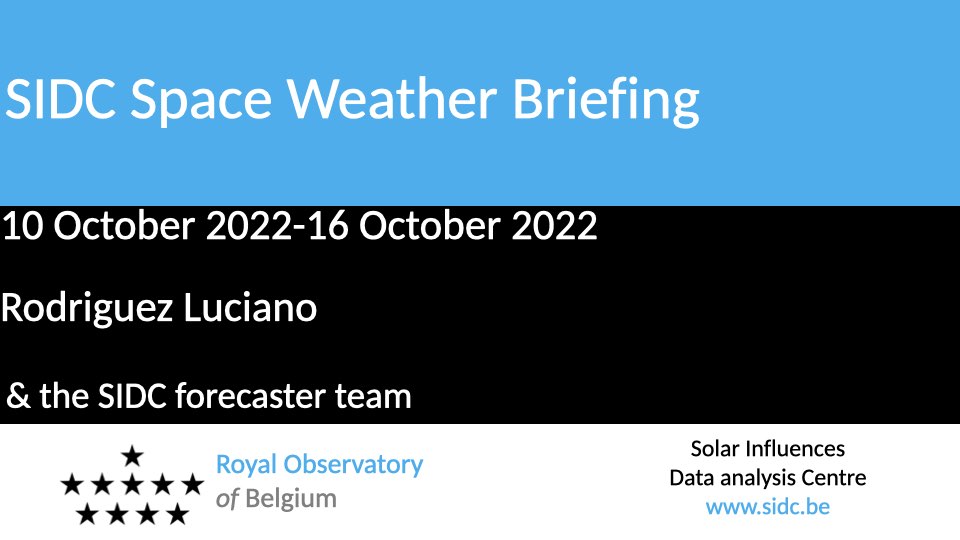
If you need to access the movies, contact us: stce_coordination at stce.be
The International Sunspot Number by SILSOal
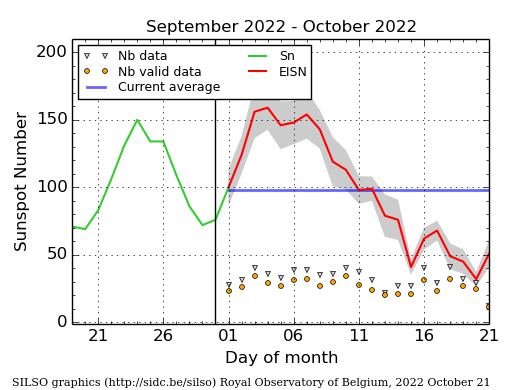
The daily Estimated International Sunspot Number (EISN, red curve with shaded error) derived by a simplified method from real-time data from the worldwide SILSO network. It extends the official Sunspot Number from the full processing of the preceding month (green line), a few days more than one solar rotation. The horizontal blue line shows the current monthly average. The yellow dots give the number of stations that provided valid data. Valid data are used to calculate the EISN. The triangle gives the number of stations providing data.
PROBA2 Observations (10 Oct 2022 - 16 Oct 2022)
Solar Activity
Solar flare activity fluctuated from low to moderate during the week.
In order to view the activity of this week in more detail, we suggest to go to the following website from which all the daily (normal and difference) movies can be accessed: https://proba2.oma.be/ssa
This page also lists the recorded flaring events.
A weekly overview movie (SWAP week 655) can be found here: https://proba2.sidc.be/swap/data/mpg/movies/weekly_movies/weekly_movie_2022_10_10.mp4.
Details about some of this week's events can be found further below.
If any of the linked movies are unavailable they can be found in the P2SC movie repository here: https://proba2.oma.be/swap/data/mpg/movies/.
Tuesday October 11
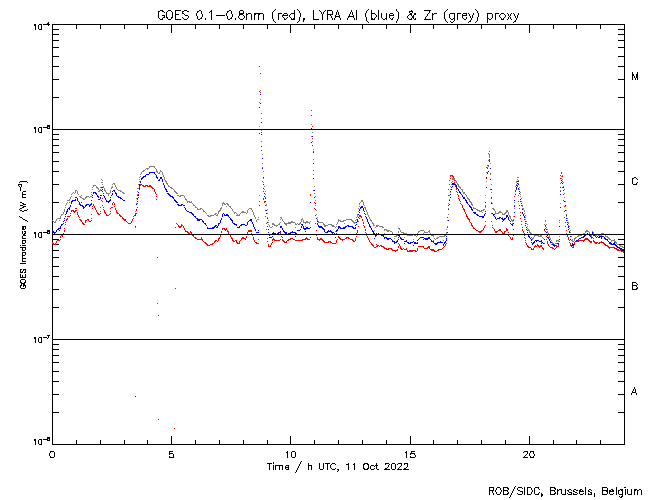
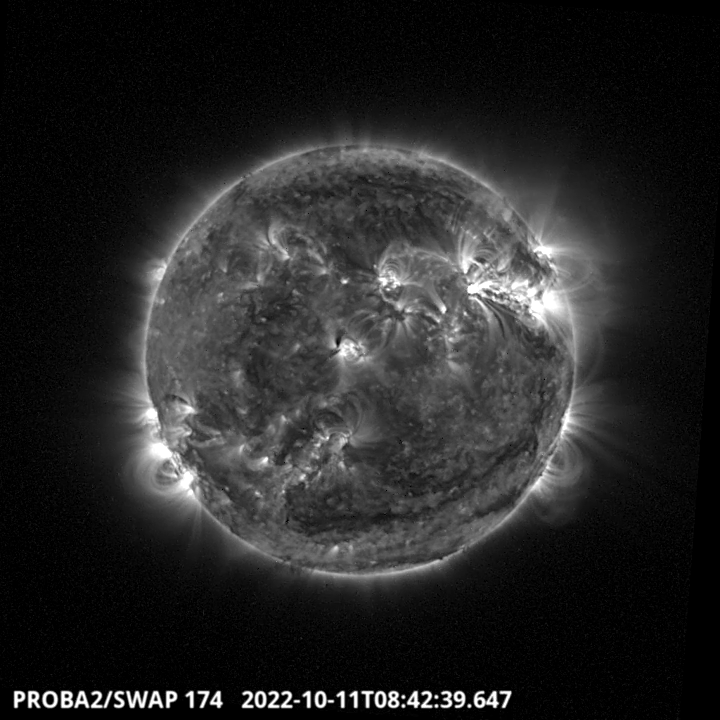
The largest flare of the week, a short M3.9 flare, was observed by LYRA (top panel) and SWAP (bottom panel). The flare occurred on 2022-Oct-11 (peak at 08:42 UT) in the north-western hemisphere, and it was associated with NOAA AR3112.
Find a SWAP movie of the event here: https://proba2.sidc.be/swap/movies/20221011_swap_movie.mp4.
Noticeable Solar Events (10 Oct 2022 - 16 Oct 2022)
| DAY | BEGIN | MAX | END | LOC | XRAY | OP | 10CM | TYPE | Cat | NOAA |
| 10 | 0035 | 0047 | 0055 | N24W26 | M1.0 | 1F | CTM/1 | 55 | 3112 | |
| 10 | 1605 | 1628 | 1647 | N24W34 | M2.4 | SF | III/1 | 55 | 3112 | |
| 11 | 0836 | 0842 | 0846 | N22W42 | M3.9 | SB | 140 | V/3 | 55 | 3112 |
| 11 | 1047 | 1052 | 1057 | M1.5 | III/3 | 55 | 3112 | |||
| 12 | 2354 | 0019 | 0037 | M1.5 | 55 | 3112 | ||||
| 14 | 0920 | 0944 | 0951 | M1.3 | 55 | 3112 | ||||
| 14 | 0951 | 0955 | 0959 | M1.3 | 55 | 3112 |
| LOC: approximate heliographic location | TYPE: radio burst type |
| XRAY: X-ray flare class | Cat: Catania sunspot group number |
| OP: optical flare class | NOAA: NOAA active region number |
| 10CM: peak 10 cm radio flux |
Action!
Check out our activity calendar: activities and encounters with the Sun-Space-Earth system and Space Weather as the main theme. We provide occasions to get submerged in our world through educational, informative and instructive activities.
If you want your event in our calendar, contact us: stce_coordination at stce.be
* October 19, seminar: Detecting Europa’s Water Plumes, onsite and online, Royal Observatory of Belgium
* October 20, seminar: The effect of flux rope heating models on solar prominence formation, onsite and online, CmPA, Leuven, Belgium
* October 20, Job vacancy EUI onboard Solar Orbiter - last day for submission
* October 24-28, 18th European Space Weather Week, Zagreb, Croatia
* November 21-23, Space Weather Introductory Course - onsite, by the STCE, Brussels, Belgium - fully booked
* November 22, seminar: Ionospheric Disturbances Detection by HF Doppler sounding, onsite and online, STCE
* November 27, Dag van de Wetenschap, Planetarium, Belgium
* December 5, 6, 8, 9, Space Weather Introductory Course - online, by the STCE, zoom - fully booked
Check: https://www.stce.be/calendar

